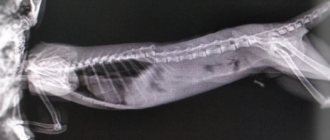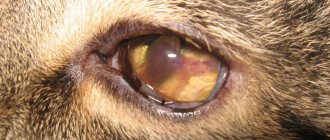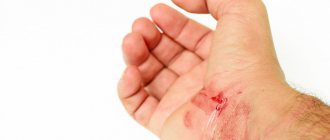A bee sting always puts the life, health and well-being of your pet at risk. Even domestic cats are not immune to disaster when a bee or wasp flies into the house. The cat's curiosity and hunting instinct will most likely cause it to pounce on the scout, who will respond to the attack with a bite. If your kitten is hypersensitive to the toxins released during a bite, this could lead to much more serious consequences than a swollen paw. Here's everything you need to know about treating a cat after a bee sting.
The bite can be dangerous
Most cats are not hypersensitive to bee or wasp venom, but if your pet is allergic, a bee sting can cause serious illness or anaphylactic shock. This threatens a sharp drop in pressure and can lead to the death of the animal. If there are any signs of an acute reaction, contact your veterinarian immediately.
You can't be sure that your cat will have a severe reaction, but you should call your veterinarian immediately after a bite and bring your pet in for an appointment to be safe. Or your doctor may recommend home treatment.
Which parts of a cat's body are most susceptible to wasp stings?
If your cat is restless and itchy, you should examine his body for insect bites..
- Wasps often sting the front paw pads, nose and mouth area.
- Much less commonly, a wasp sting can occur on the nose or lower part of the paw.
Very rarely, other parts of the body are attacked by wasps. This is due to the fact that the wasp inflicts chaotic attacks quite rarely, more often if the cat does not retreat. It is also almost impossible for wasps to get through the thick fur of a cat, so the muzzle and paws are the most easily accessible parts of the body. The exception is hairless breeds.
© shutterstock
A wasp sting for a cat is a signal that one should immediately leave the place of conflict, therefore multiple bites are possible only if the animal, due to inexperience, has ravaged the wasp hive.
Recognizing the signs of a bite
In most cases, cats exhibit a localized reaction where the bite area becomes slightly swollen and tender. Often, a bee or wasp can sting in the face, usually in the nose area, or in the paw. Check to see if the sting remains on the skin. When a bee stings, it leaves a sting with spikes in the body of the victim. Wasps do not lose their stings, so they can sting a victim several times in a row, which increases the degree of threat to your pet.
Severe swelling, redness and pain are the first signs of an acute reaction. The animal may show that it is in pain, for example, it will begin to limp or hobble, meow loudly, or vigorously lick the bite site. The following symptoms are observed in anaphylactic shock:
- Rash.
- Disorientation or stumbling.
- Vomiting or diarrhea.
- Pale gums.
- Low body temperature and cold extremities.
- Fast or slow heart rate.
According to the North Asheville Veterinary Clinic, other signs to watch for include fainting, shallow or rapid breathing, increased salivation, changes in behavior, mood, and thinking abilities. If any of these signs occur, take your pet to a veterinarian immediately.
How to tell if a cat has been bitten
The first signs immediately after the bite:
- Restless behavior. The cat shakes its head or paw, may run away somewhere and hide, or will rush about and may be injured by sharp objects;
- Subsequently, swelling and pain develop at the site of the bite. Lameness may occur if the bite is on the paw;
- the most serious condition develops if the bite is in the mouth: the tongue, cheeks or palate are swollen, the mouth is open all the time, profuse salivation;
- further, all symptoms develop individually: there may be vomiting, rapid heartbeat, feverish trembling, fluctuations in body temperature, disorientation in space, unsteadiness of gait, convulsions and loss of consciousness;
- in case of an acute allergic reaction, severe lethargy develops, the cat falls to the ground and breathes heavily.
Bee sting treatment
If the sting is still in your pet's skin, it must be removed immediately. Venom from the sting can enter the pet’s blood within three minutes after the bite. Use the sharp edge of a credit card to remove the sting. You can remove the sting with tweezers or your fingers, but then you risk damaging the venom sac, which will enter the bloodstream.
After removing the sting, monitor your cat closely for any acute reactions. If she has a mild, localized reaction, call your veterinarian immediately. If your doctor doesn't advise you to bring her in for a checkup, he may recommend an antihistamine, such as diphenhydramine, which slows the body's response to the histamines in the venom.
You may want to administer diphenhydramine yourself without consulting a professional, but be careful: some over-the-counter medications containing diphenhydramine may contain other ingredients, such as pain relievers, that can be dangerous for your pet and can even be fatal. Your veterinarian will not only recommend the safest drug, but also the correct dosage.
To treat mild swelling at home, you can apply a cold compress or wrap a cold towel around the affected area. Under no circumstances should you give your cat over-the-counter pain medications that may be toxic to her. Severe pain in a pet may be a sign of an acute reaction. If you notice any signs of an allergic reaction, you should take your cat to your veterinarian or emergency veterinary service immediately.
It is also necessary that the cat does not touch the wound in the future. If she is bitten on the paw, try to lay her down so she doesn't scratch the wound. If a cat is bitten in the face, it may try to scratch the affected area - try to prevent this. Scratching the wound can aggravate the swelling and pain, so reassure the animal and allow it to rest peacefully.
Priority actions in case of a bite
If a cat is bitten by a wasp, you need to provide first aid, which will help avoid deterioration of health, without causing harm to the pet’s body. To do this you should:
- Carefully examine the affected area of the body, if necessary, remove the sting with tweezers and try to squeeze out the poison.
- Treat the bite site with a disinfectant. It is recommended to wash the area with soapy water and apply a compress of baking soda and boiled water. You can apply a piece of ice wrapped in a cloth to the inflamed area - this will help relieve swelling.
- Give the animal an antihistamine, and if severe swelling occurs, a diuretic should be used.
- Provide your pet with peace and do not leave it alone until its condition normalizes or a doctor arrives.
We recommend the article: Can a healthy kitten have a dry nose?
It is important not to panic and start acting as soon as possible after the incident.
Preventing a Bite
Sometimes a bee or wasp may bite your cat despite your best efforts, so try to keep these insects out of your home. There are still steps you can take to reduce your pet's risk of being bitten.
If you find a nest or hive in your yard, call a professional to remove it safely. If an insect flies into the house, take the cat and all other pets into the room and lock the door. Do not open the door until you kill the insect or drive it outside. If your cat corners an insect, immediately check that it is safe. If the prey turns out to be a bee or wasp, remove the cat from the insect and lock it in another room until you deal with the raider. If you are using insect exterminator to get rid of wasps or hives, be sure not to get it on your cat, as it could make her sick or die.
A bee sting is not always a reason to panic, but it is always something to take seriously. A quick reaction and careful observation of your cat will help you save its life.
Folk remedies
The main advantage of using traditional medicine is that it can be used in almost unlimited quantities. After a cat has been bitten by a wasp, you can use the following to quickly get rid of swelling at home:
- Products that contain acids - orange, apple or lemon. To quickly get rid of swelling and partially neutralize the effect of the poison, wipe the affected area with the juice of these fruits;
- Chamomile compress – applied to the bite site for half an hour;
- Turmeric – will help get rid of itching and relieve inflammation;
- Soap solution - to reduce itching, you need to wipe the inflamed area every hour.
Such remedies can help an animal when swelling occurs without aggravating symptoms.
What to do if a cat is bitten by a wasp
Immediately after the bite
First aid is to treat with an antiseptic. If swelling persists, applying cold water will be enough.
First time
After a bite, you need to observe the animal for the first time. If it calms down and behaves as usual, then there shouldn’t be a problem.
For allergies
If allergy symptoms occur, an antihistamine can be given to relieve them. However, it is better to discuss its quantity with a veterinarian, at least over the phone.
How to protect a wound
You need to try to prevent the animal from scratching the wound. If it is a paw, wrap it up and seal the muzzle as much as possible.
If all else fails
For other symptoms, you should immediately consult a doctor.
Prevention
It is almost impossible to completely protect your cat from being bitten, but when he spends the summer season outdoors, the possibility of insect damage should be minimized. For this:
- The windows are covered with mosquito nets, the doors are hung with curtains;
- Periodically inspect the territory, destroy existing bee nests;
- Treat pets with repellents.
It is not recommended to feed cats outside; here it is much easier for insects to get into the food, and accordingly the risk of being struck by a wasp is much greater.
Why do cats bite?
Cats can, of course, become aggressive when they are scared or feel threatened. But many also tend to bite and scratch when petted by their owner. This is called petting-induced aggression, and it has been a topic of discussion among behaviorists for decades. There are three theories why cats do this. First, they are simply letting their owner know that they are no longer happy to be petted. Secondly, they are trying to establish their status. Thirdly, a person who pets them for a while causes negative emotions in cats. It is important for owners to learn more about their cats in order to recognize the telltale signs of aggression caused by petting.
Photos of cats stung by bees
In the photo you can see how swelling develops in cats bitten by bees.
The muzzle at the site of the lesion swells, the eye closes.
Important! When a bee bites a cat on the nose, it develops swelling not only on the skin, but also in the respiratory tract, which threatens the death of the animal.
Getting a sting in the face or cheek can also lead to serious swelling:
Allergy
If a bee sticks its sting into the muzzle area, there is a high probability of swelling of the larynx, which makes breathing difficult. Your cat should be immediately given adrenaline and antihistamine therapy, i.e. Give an antiallergic drug: ointment, tablets, drops.
Pedigree pets and cats with weak immunity are more susceptible to the development of reactions. Don't worry if your kitten swallowed a wasp or it doesn't bite inside the stomach. Make sure that the insect does not manage to sting the oral cavity. A bee sting is excluded when no symptoms appear within 30 minutes.
Symptoms
The owner does not always have the opportunity to keep track of his pet, but based on his behavior he should suspect the fact of a wasp sting. The cat often meows pitifully, scratches, and licks the stung area. A more detailed examination of the lesion usually reveals a red spot, swelling, marks from claws, teeth, with which the animal wants to quench the itching that has arisen.
The degree of inflammation depends on the weight, age and type of insect that bit your pet. The most extensive swelling will appear in a kitten stung by a bee on the nose, cheeks or eyes. A wasp bite on the tongue is especially dangerous. The symptoms here are similar to those in humans:
- round redness;
- edema;
- burning, itching;
- pain.
An animal stung by an aggressive bee rushes around the corners, its behavior is restless, sometimes violent. When wasp venom gets into your cat's paw, lameness occurs. These signs are caused by a developing allergy to wasp toxin, which is accompanied by the above consequences, as well as:
- diarrhea;
- lacrimation;
- convulsions;
- swelling of the larynx;
- increased temperature;
- lack of appetite, weakness.
In mild cases of a wasp or bee sting, all signs disappear on their own after a few days. But in view of the existing danger of damage to your pet’s respiratory tract and the onset of suffocation, veterinarians recommend taking immediate action immediately after detecting a problem.
First aid
If a bee stings, its sting remains in the body. The slightest touch to it increases the pain. Therefore, it is so important to locate the bite site and remove the sting from the cat.
This must be done extremely carefully, otherwise the sting will break and its poisoned tip will remain under the skin. In this case, it is more difficult to remove the fragment. You may even need surgery.
The place where the cat was bitten by a bee is treated with an antiseptic. This will help reduce inflammation. A cold compress is then applied to the swollen area.
Antiseptic











